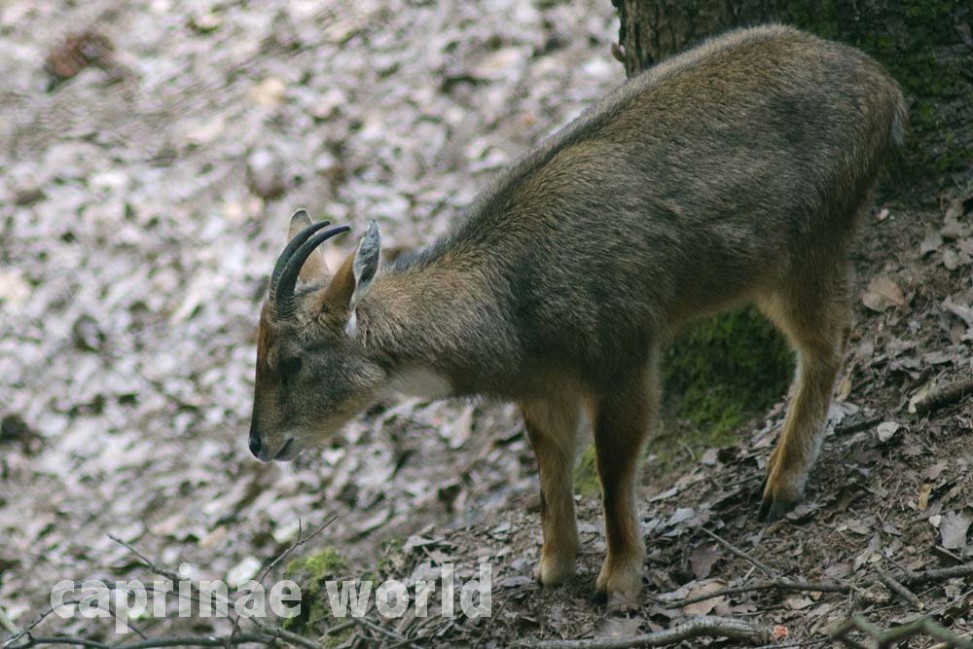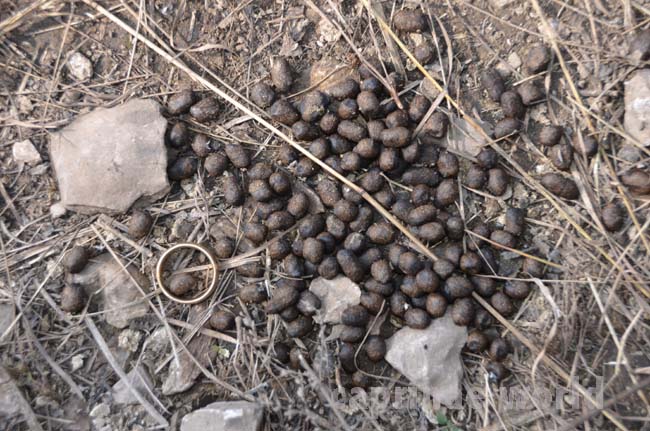The Himalayan Grey Goral is the lighter greyish variety of the two Himalayan Goral species.
Names
Czech: goral západohimálajský [10]
English: Himalayan Gray Goral [3], Himalayan Grey Goral [10]
French: Goral de Bedford [3]
German: Westhimalaya-Goral [3]
Hindi: goral [5]
Nepali: Ghoral [5]
Spanish: Goral gris del Himalaya [3]
Tibetan: Nawa [5]
The generic name was originally spelled Naemorhedus, but the spelling Nemorhaedus, despite being an unjustified emendation, is in „prevailing“ usage and is used here as well. [3] Check the Himalayan Goral chapter for the species name change.
Taxonomy
Type species: Antilope goral Hardwicke 1825 [10]
Type material: limited to an illustration in the original work, the species was described on the basis of a live animal (male) in the menagerie in Barrackpore (West Bengal). It is likely that the type specimen has not been preserved or has been lost. [10]
Type locality: Kathmandu, Nepal [10]
Synonyms: Antilope goral Hardwicke 1825, Urotragus bedfordi Lydekker 1905 [10]
Distribution
by country: Pakistan (Kashmir), India (Northwest), Nepal, China
The northwest boundary of this species’ distribution can be found in northern Pakistan, where it inhabits the Himalayan foothills in the rolling countryside of the provinces of Khyber Pakhtunkhwa, Punjab, Islamabad and Azad Kashmir (Abbas et al. 2012). [10]
In India it has settled the states of Jammu and Kashmir, Himachal Pradesh, Uttarakhand and the northern part of Haryana. The species further extends into Nepal, where it occurs in small patches up to the Kathmandu Valley or along the Sun Kosi River, although the exact eastern boundary is not known. In Nepal the species has been documented in several of the most southern locations in the framework of its overall distribution. One of the southernmost populations inhabits the Mahabharat Range (27°45’N, 84°04’E), where a protected area of the same name was declared for it (Thapa et al. 2011). [10]
It is also newly documented in China, specifically in the basin of the Gyirong Zangbo River (28°17’N, 85°22’E). [10]
General discription
Body and horn measurements are similar to the Himalayan Brown Goral. [1, 3]
length / head-body: 95-130 cm
shoulder height: 66-71 cm
weight: 35-42 kg [1]
tail: relatively short, usually not longer than 7,5 cm [1]
back: slightly arched [1]
facial profile: concave [1]
horn length: 13-18 cm [1]
life expectancy: 15 years in captivity, likely less in the wild [5]
Colouration / pelage
summer coat: very light, varying from reddish grey-brown to greyish fawn, rarely a pure pale grey or brownish colour occurs. Ventral parts of the body typically have a lighter tone, very exceptionally they are also pure white. As with all other species of goral dark pattern form longitudinal stripes. [10]
nuchal / dorsal stripe: In some individuals, especially males, a hint of a nuchal stripe appears behind the horns and usually ends in the area of the withers; this is a light brownish-grey and the hairs are extended to form a short mane, but the stripe is often not distinctive and the mane may be the colour of the body. A line continuing in the form of a dorsal stripe is also lacking. [10]
ventral side of the body: a dark stripe stretches along the medial plane from the presternal region ending roughly at the level of the elbow joints. This pattern occurs more often in males, and is usually lacking in females. [10]
limbs: This light colouring can also extend to the medial surfaces of the limbs. On the thoracic limbs it extends down to the hooves, on the pelvic limbs it usually stops just below the hocks. Distally from the radiocarpal joints and hocks, respectively, the limbs may be contrastingly coloured in ochre or cream. Dark stripes are formed on the dorsal areas of the thoracic limbs between the radiocarpal joints and fetlocks. Rarely may they be missing, or conversely, they may extend proximally up to the elbow joints. Dark stripes on the pelvic limbs are usually missing. [10]
throat patch: white; very large; rostrally it always extends to the interramal region, on the chin and lower lip, and in some individuals it reaches laterally to the cheeks, from where it passes on to the upper lip. Caudally the throat patch extends at least half the length of the neck where it forks, ending in two tips. [10]
head: The colour transition on the head is gradual, (while on the neck, it is clearly defined). A dark brown to black nasal stripe extends from the rhinarium and fades away in a wedge-shape at roughly eye level. On the upper lip there is a white crescent on both sides on the philtrum, which on the lateral edge sometimes merges with the large throat patch. On the caudal side of the base of the auricle, there is another conspicuous light patch, which can be best observed when the animal points its ears forward. [10]
pubic region and the perineal region: cream-coloured. [10]
scrotum: grey or tan coloured. [10]
rump patch: lighter-coloured; narrow; usually completely hidden by the tail. [10]
tail: At the base of the tail, somewhat extended, contrastingly white hairs grow up from the lateral surfaces and line the sides of the tail. Most of the dorsal surface of the tail is coloured the same as the body up to the black tip which, in some individuals, may be extended into a terminal tuft. [10]
winter coat: very similar to the summer coat, but tends to have more grey tones. It also preserves the light patches and dark patterns on all of the places described above. [10]
colouring of the young: virtually identical to the adult animals. The light patches occur in the usual places. The dark pattern on the head, body and limbs is less clear, sometimes even lacking. A dark brown to black crest often forms between the auricles; some of the young have several pure white hairs disseminated in its centre. This dark crest disappears with maturity. [10]
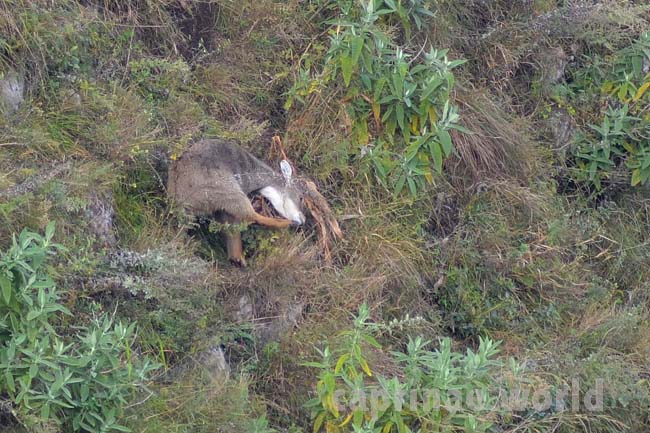
The throat patch in Himalayan Grey Goral is white and very large. Photo: Ralf Bürglin, Majathal Sanctuary, India
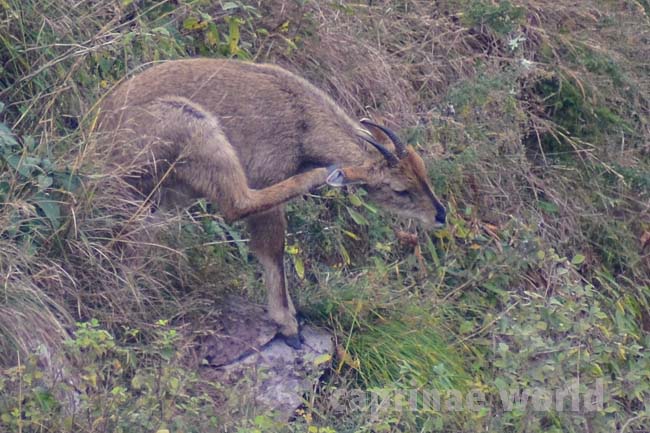
Male Himalayan Grey Goral. Note the dark brown to black nasal stripe that extends from the rhinarium and fades away in a wedge-shape at roughly eye level. Photo: Ralf Bürglin, Majathal Sanctuary, India
Horns
Both sexes have short, pointed, slightly curving horns. [1]
male horns: regularly attaining a length of 20 cm or more. They are conspicuously backward-curved and from the base to about two-thirds of the length they are noticeably, but relatively shallowly ribbed with about 10 grooves. [10]
female horns: in contrast rather short, often only 10–15 cm; more or less straight or only slightly curved and almost smooth. [10]
The horns of the Himalayan Grey Goral are somewhat longer, more curved and more heavily serratred than those of the brown form. [1]
The goral trophy with the longest horns was collected near the Mussoorie Hill Station in Uttarakhand, India, in 1902. The length was 23,2 cm, circumference 9,5 cm. [1]
Habitat
The Himalayan Grey Goral reportedly occurs at elevations of 350-3000 m [3] or 1800-2500 m respectively [1] in similar habitat types as the Himalayan Brown Goral [3]. In Pakistan, the Himalayan Grey Goral occurs in the Himalayan foothills [1, 3] in diverse plant communities, including scattered pine and thorny shrub habitats. In north-western India, they occur at 350-700 m in one area and above 1600 m in another area, on slopes with a median gradient of greater than 30-40°. They seek security cover in dense, tall vegetation in steep, rocky terrain. [3]
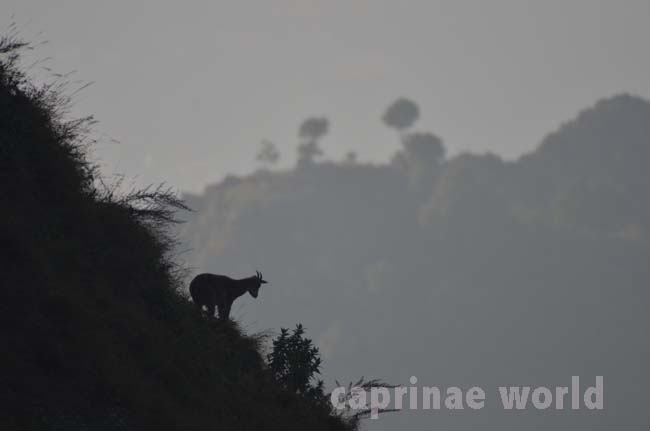
The Himalayan Grey Goral prefers slopes with a median gradient of greater than 30-40° [3]. Photo: Ralf Bürglin, Majathal Sanctuary, India
Food and feeding
Annual diet of Himalayan Grey Goral consists of 63 percent grass, 36 percent shrubs, and 1 percent tree leaves. [3] Goral at Majathal Harsang Wildlife Sanctuary fed almost entirely on grass – 92 percent in the cold season and 98 percent in the warm season [9].
Breeding
Territoriality: males during rut [3]
Mating-season activity: males join female herds. Mixed herds consist of a single adult male, adult females and their young, and subadult females. Adult males chase adult females. [3]
Sexual maturity: at 2-3 years [3]
Mating: November-December [3, 8]
Gestation: about 180 days [3, 8]
Parturition: April to May [3]; May and June in Pakistan [8]
Young per birth: single offspring is the norm, rarely twins [3, 8]
Activity patterns
The Himalayan Grey Goral is primarily diurnal. It avoids open areas when temperatures exceed 20°C. Temperature is probably a major factor determining daily and seasonal activity and habitat use. [3]
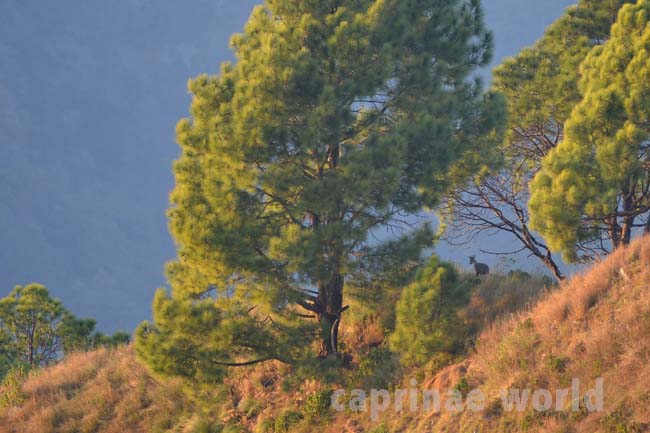
Himalayan Grey Goral seek the shade when temperatures exceed 20°C [3]. Photo: Ralf Bürglin, Majathal Sanctuary, India
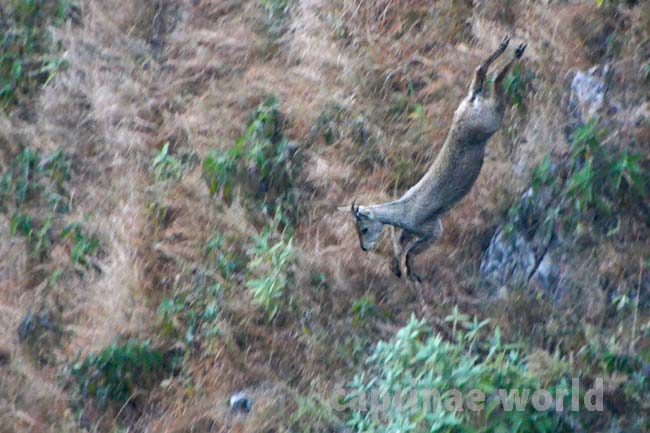
Goral are extremely agile and can move at high speeds across rough terrain. Photo: Ralf Bürglin, Majathal Sanctuary, India
Mortality / predators
In Pakistan Himalayan Grey Goral have been documented to die due of deseases and parasites. [6] At one site in Pakistan wolf and jackal were identified as predators. [7]
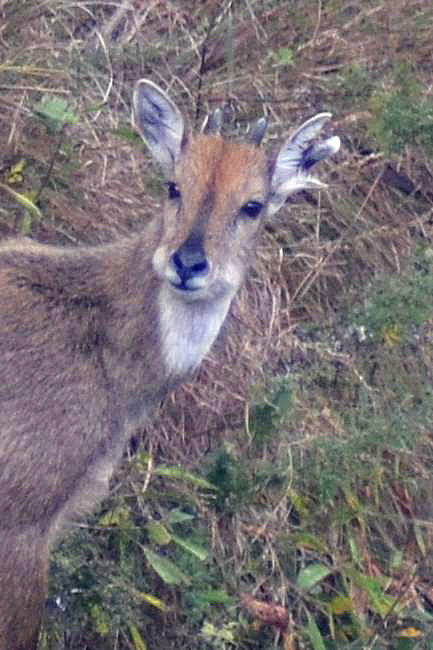
Himalayan Grey Goral at Majathal Sanctuary. Note the shredded left ear, which could be caused by a predator. Leopards are known to occur at Majathal sanctuary. Photo: Ralf Bürglin
Movements, home range and social organisation
Older males are primarily solitary; 60 percent of sightings in winter and 61 percent in summer were of soltiary adult and subadult males. In north-western India, 69 percent of males were solitary; fewer than 30 percent of females were by themselves. In Pakistan Himalayan Grey Goral were observed to migrate to lower areas during winter. [7]
Mean group size was 1,8 in winter and 1,6 in summer, with herds up to 11. In another area, mean mixed group size was 2,9. Population density was 4,6 to 10,5 individuals per km². [3] In Pakistan mean population density of Grey Goral in Machiara National Park was 2.66 individuals per km². The population of Himalayan Grey Goral was higher in Machiara National Park (4,57/km²) than in unprotected Serli Sacha site (0,76/km²). The minimum herd size was 2, while maximum herd size was 6. Larger groups were frequent in less disturbed areas in contrast to highly disturbed areas. [8] Gorals have a matriarchal society, consisting of a basic family group of an adult female with one or two young of the year and other offspring 1 to 3 years old. Larger groups were observed in disturbed areas. [3]
Conservation Status / threats
On the IUCN Red List the Himalayan Grey Goral is listet as „near threatened“ (as N. g. bedfordi). [2] Many populations are small and fragmented. [3]
Widespread habitat alteration and disturbance, primarily illegal hunting and competition with livestock [3], also collection of fodder, fuel wood and medicinal herbs [8] are major threats. [3] One study from Pakistan reveals that gorals do not raid crops, however people hunt and trap them for recreation and food, but less so to make a living [5]. Strict inforcement of game laws and creation of additional protected areas are a priority. Community-based conservation programs that emphasize integrated natural resource management would be beneficial to wildlife and human communities. [3]
For Pakistan 700 to 1000 individuals are mentioned [1, 8]. In the peripheral areas of its occurrence, it is extremely rare. It has disappeared from a number of its historical sites and the once contiguous distribution has broken up into 7 isolated populations (Abbas et al. 2012). Probably the strongest Pakistani population inhabits the province of Azad Jammu and Kashmir to the northeast of the country (Abbas et al. 2012). [10]
It is a quite commonly observed species in suitable habitats in India. To the northwest of the country, in the state of Jammu and Kashmir, it only occurs in patches (e.g. Hilaluddin et Naqash 2013). Further east in the state of Himachal Pradesh it is common locally, especially in well-functioning protected areas, where it is observed regularly (Cavallini, 1992). It is most numerous in the Indian state of Uttarakhand, where it inhabits a number of habitats. Its occurrence in the state of Haryana is only local. [10]
The Nepalese populations are locally numerous for now, although it is intensively hunted despite its legislative protection. Population dynamics were not investigated in the past, but the frequency of observations has declined rapidly in recent years. [10]
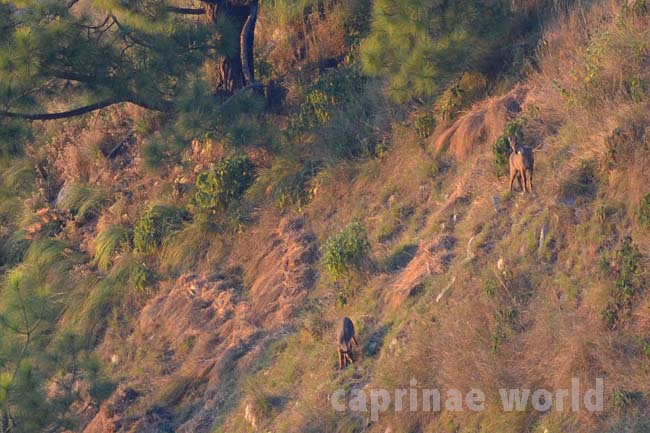
Two gorals at Majathal Sanctuary, where local women have cut grass for fodder previously. Goral can occur in good numbers if suitable habitats are available and grass and fodder cutting is moderate. [1] Photo: Ralf Bürglin, Majathal Sanctuary, India
Trophy hunting
Trophy hunting is not conducted at present. But various authors emphasize that prioritizing economically viable alternative uses such as sustainable trophy hunting, would be beneficial to wildlife and human communities. [1, 3]
Ecotourism
Majathal sanctuary in Himachal Pradesh is currently probably the best place to watch Himalayan Grey Goral. Himachal Pradesh Tourism and other institutions promote the area.
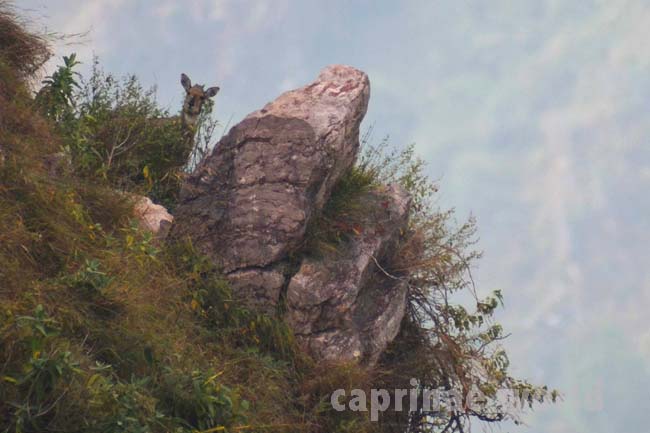
Photo: Ralf Bürglin, Majathal Sanctuary, India
Literature Cited
[1] Damm, Gerhard R. and Franco, Nicolás, 2014: The CIC Caprinae Atlas of the World – CIC International Coucil for Game and Wildlife Conservation, Budakeszi, Hungary in cooperation with Rowland Ward Publications RSA (Pty) Ltd., Johannesburg, South Africa.
[2] Duckworth, J.W. & MacKinnon, J. 2008. Naemorhedus goral. The IUCN Red List of Threatened Species 2008: e.T14296A4430073. http://dx.doi.org/10.2305/IUCN.UK.2008.RLTS.T14296A4430073.en. Downloaded on 16 January 2017.
[3] Wilson, D.E. and Mittermeier, R.A. [eds], 2011: Handbook of the Mammals of the World. Vol. 2. Hoofed Mammals. Lynx Edicions, Barcelona.
[4] Groves, Colin and Grubb, Peter, 2011: Ungulate Taxonomy. The John Hopkins University Press.
[5] Castelló, José R., 2016: Bovids of the World – Antelopes, Gazelles, Cattle, Goats, Sheep, and Relatives. Princton University Press.
[6] Perveen, Farzana, Khan, Anzela and Adnan Hussain Shah: Hunting and Trapping Pressures on the Himalayan Goral, Naemorhedus Goral (Hardwicke) (Artiodactyla: Bovidae) in Kohistan, Pakistan. American Journal of Zoological Research 1, no. 1 (2013): 5-11.
[7] Perveen, Farzana and Khan, Anzela: Migratory status of the goral, Naemorhedus goral (Hardwicke) (Artiodactyla: Bovidae) in Kohistan, Pakistan. International Journal of Biodiversity and Conservation, Vol. 5 (10), 2013, pp. 671-677
[8] Ashraf, N. et al: Population parameters of Grey Goral (Naemorhedus goral goral) at two different sites in Machiara National Park, Azad Jammu and Kashmir. The Journal of Animal & Plant Sciences, 25(1): 2015, pp 88-94
[9] Mishra, C. and Johnsingh, A. J. T.: On habitat selection by the goral Nemorhaedus goral bedfordi (Bovidae, Artiodactyla). Journal of Zoology, Volume 240, Issue 3, November 1996 , Pages 573–580
[10] Hrabina, Petr: „A new insight into the taxonomy and zoogeography of recent species of goral (Nemorhaedus, Bovidae, Ruminantia)“, Gazella 42, 2015, Zoo Praha

